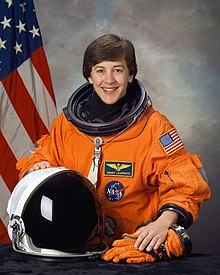Wendy B. Lawrence
| Wendy Barrien Lawrence | |
 | |
| NASA-astronaut | |
|---|---|
| Född | 2 juli 1959 Jacksonville, Florida |
| Tid i rymden | 51 dagar, 3 timmar, 56 minuter |
| Urvalsgrupp | Astronautgrupp 14 |
| Uppdrag | STS-67, STS-86, STS-91, STS-114 |
| Uppdragsemblem | |
Wendy Barrien Lawrence, född 2 juli 1959 i Jacksonville, Florida, är en amerikansk astronaut uttagen i astronautgrupp 14 den 5 december 1992.
Wendy Lawrence arbetar som befälhavare i USA:s flotta, hon är också helikopterpilot, ingenjör och astronaut i NASA. Hon var den första kvinna, utexaminerad från den amerikanska sjökrigsskolan, som gjorde en rymdresa. Hon har besökt den ryska rymdstationen Mir och den Internationella rymdstationen (ISS).
Rymdfärder
Referenser
”Biographical Data” (på engelska) (PDF). NASA. augusti 2006. https://www.nasa.gov/wp-content/uploads/2016/01/lawrence_wendy_0.pdf?emrc=90b8bf. Läst 3 maj 2024.
Media som används på denna webbplats
The STS-86 flight was the seventh shuttle-Mir docking mission, symbolized by seven stars. The international crew includes astronauts from the United States, Russia, and France. The flags of these nations are incorporated in the rays of the astronaut logo. The rays of light streaking across the sky depict the orbital tracks of the two spacecraft as they prepare to dock. During the flight, an American astronaut and a Russian cosmonaut will perform an extravehicular activity (EVA). The mercator projection of Earth illustrates the global cooperative nature of the flight.
Emblem of Nasa's STS-114 mission.
- The STS-114 patch design signifies the return of the Space Shuttle to flight and honors the memory of the STS-107 Columbia crew. The blue Shuttle rising above Earth’s horizon includes the Columba constellation of seven stars, echoing the STS-107 patch and commemorating the seven members of that mission. The crew of STS-114 will carry the memory of their friends on Columbia and the legacy of their mission back into Earth orbit. The dominant design element of the STS-114 patch is the planet Earth, which represents the unity and dedication of the many people whose efforts allow the Shuttle to safely return to flight. Against the background of the Earth at night, the blue orbit represents the International Space Station (ISS), with the EVA crewmembers named on the orbit. The red sun on the orbit signifies the contributions of the Japanese Space Agency to the mission and to the ISS program. The multi-colored Shuttle plume represents the broad spectrum of challenges for this mission, including Shuttle inspection and repair experiments, and International Space Station re-supply and repair.
STS-67 Mission Insignia
Astronaut Wendy B. Lawrence, mission specialist.
This is the crew patch for the STS-91 mission – the ninth flight of the Shuttle-Mir Phase One docking missions. The crew will bring back Andrew S. W. Thomas, the last long-duration American crew member flown on the Russian Space Station Mir. This mission marks the end of the Shuttle-Mir Phase One Program and will open the way for Phase Two: construction of the International Space Station (ISS).
The crew patch depicts the rendezvous of the Space Shuttle Discovery with the Space Station Mir. The flags of the United States and Russia are displayed at the top of the patch and both countries are visible on the Earth behind the two spacecraft. The names of the American crew members surround the insignia on the outer areas, with the name of cosmonaut Valeriy Ryumin in Cyrillic at the lower right.





